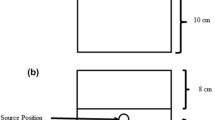Abstract
In vivo dosimetry is recommended as a defence-in-depth strategy in radiotherapy treatments and is currently employed by clinics around the world. The characteristics of a new optically stimulated luminescence dosimetry system were investigated for the purpose of replacing an aging thermoluminescence dosimetry system for in vivo dosimetry. The stability of the system was not sufficient to satisfy commissioning requirements and therefore it has not been released into clinical service at this time.










Similar content being viewed by others
References
Lye J, Dunn L, Kenny J, Lehmann J, Kron T, Oliver C, Butler D, Alves A, Johnston P, Franich R, Williams I (2014) Remote auditing of radiotherapy facilities using optically stimulated luminescence dosimeters. Med Phys 41(3):032102
Danzer J, Dudney C, Seibert R, Robison B, Harris C, Ramsey C (2007) TH-C-M100E − 02: optically stimulated luminescence of aluminum oxide detectors for radiation therapy quality assurance. Med Phys 34(6):2628–2629
Akselrod MS, Bøtter-Jensen L, McKeever SWS (2006) Optically stimulated luminescence and its use in medical dosimetry. Radiat Meas 41:S78–S99
Yukihara EG, McKeever SWS (2011) Opically stimulated luminescence funimentals and applications. John Wiley & Sons Ltd., Chichester
IAEA (2000) Lessons learned from accidental exposures in radiotherapy, IAEA Safety Report Series 17. International Atomic Energy Agency, Vienna
ARPANSA (2008) Radiation Protection in Radiotherapy safety guide RPS 14.3. Australian Radiation Protection and Nuclear Safety Agency, Canberra
Van Dam J, Marinello G (eds) (2006) Methods for in vivo dosimetry in external radiotherapy. ESTRO, Brussels
Millar M, Cramb J, Das R, Ackerly T, Brown G, Webb D (1996) Recommendations for the safe use of external beams and sealed brachytherapy sources in radiation oncology. Australasian College of Physical Scientists and Engineers in Medicine, Mascot
Lancaster CM, Crosbie JC, Davis SR (2008) In-vivo dosimetry from total body irradiation patients (2000–2006): results and analysis. Australas Phys Eng Sci Med 31(3):191–195
Gagliardi FM, Roxby KJ, Engstrom PE, Crosbie JC (2009) Intra-cavitary dosimetry for IMRT head and neck treatment using thermoluminescent dosimeters in a naso-oesophageal tube. Phys Med Biol 54(12):3649–3657
Charles PH, Crowe SB, Kairn T, Kenny J, Lehmann J, Lye J, Dunn L, Hill B, Knight RT, Langton CM, Trapp JV (2012) The effect of very small air gaps on small field dosimetry. Phys Med Biol 57(2012):6947–6960
Dunn L, Lye J, Kenny J, Lehmann J, Williams I, Kron T (2013) Commissioning of optically stimulated luminescence dosimeters for use in radiotherapy. Radiat Meas 51–52:31–39
Jursinic PA (2007) Characterization of optically stimulated luminescent dosimeters, OSLDs, for clinical dosimetric measurements. Med Phys 34(12):4594–4604
Omotayo AA, Cygler JE, Sawakuchi GO (2012) The effect of different bleaching wavelengths on the sensitivity of Al2O3: C optically stimulated luminescence detectors (OSLDs) exposed to 6 MV photon beams. Med Phys 39(9):5457–5468. doi:10.1118/1.4742865
Acknowledgments
The authors acknowledge Leon Dunn (Olivia Newton-John Cancer & Wellness Centre) for his advice, Mr Phil Francis (RMIT University School of Applied Sciences) for his assistance with scanning electron microscopy and Neil Brouwer (WBRO) for skilful fabrication of custom jigs. This study applies only to the specific OSL equipment used at WBRO and does not necessarily apply to other products by the same manufacturer or others.
Author information
Authors and Affiliations
Corresponding author
Rights and permissions
About this article
Cite this article
Conheady, C.F., Gagliardi, F.M. & Ackerly, T. Characterising an aluminium oxide dosimetry system. Australas Phys Eng Sci Med 38, 447–453 (2015). https://doi.org/10.1007/s13246-015-0365-2
Received:
Accepted:
Published:
Issue Date:
DOI: https://doi.org/10.1007/s13246-015-0365-2




